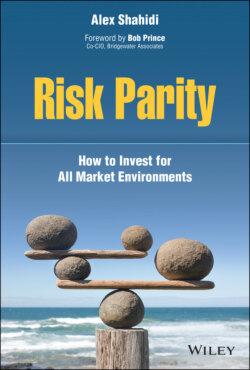Читать книгу Risk Parity - Alex Shahidi - Страница 20
THE SOURCE OF RETURNS
ОглавлениеInvestors have a choice when deciding how to allocate their portfolio. The safest bet is to leave all the money in cash and earn a guaranteed rate of return. The return is based on the prevailing interest rate at the time. You can think of the rate offered by a bank in a savings account or in insured certificates of deposit (CDs) as examples. Money market funds are also considered very low risk investments that provide interest payments without risk of principal. The Federal Reserve of the United States effectively sets the rate of cash. Over time, cash rates have fluctuated as the economic environment has shifted. In the early 1980s, cash yields were over 10% and as of this writing in 2021, they are closer to 0%.
Investors who seek higher returns than cash, have the option to take greater risk (which will be defined next) with their assets. In order to be enticed to purchase investments with safe cash, various asset classes should offer a return premium over cash. In other words, unless you expected to earn a reasonable excess return above cash over time by taking risk, you would not take the risk. This “risk premium” can be observed by measuring the long‐term performance difference between risky investments and cash. For example, since 1926 the stock market has outpaced cash by about 5% per annum.
In general, asset classes that are riskier have delivered greater excess returns than those that are less risky. This should make sense since investors should pay attention to the level of compensation for a certain level of risk. Why would I take a lot of risk to earn just a little more return? As a result, historical asset‐class returns and risk are somewhat proportional: those with greater risk offer higher expected returns than those with less risk.
My ultimate goal in this book is to walk through an efficient way to capture the risk premiums available in various asset classes. That is, we wish to identify the best way to seek better returns than cash by investing in a diverse set of asset classes while minimizing risk. In fact, we seek returns much better than cash and want to be thoughtful about how to achieve this objective without taking undue risk.
It is important to note that there is no attempt to predict what the future economic environment may look like or which asset classes will be the best performers over the next market cycle. We want to be, by and large, indifferent to what environment transpires next and how it may shift through time. We are trying to identify a thoughtful, neutral portfolio that can stand the test of time through a passive long‐term allocation without the need for tactical decision‐making. In fact, the design of this balanced allocation assumes that the future twists and turns of the markets are inherently difficult to anticipate in advance. This is why it makes sense to maintain a well‐diversified portfolio at all times.
